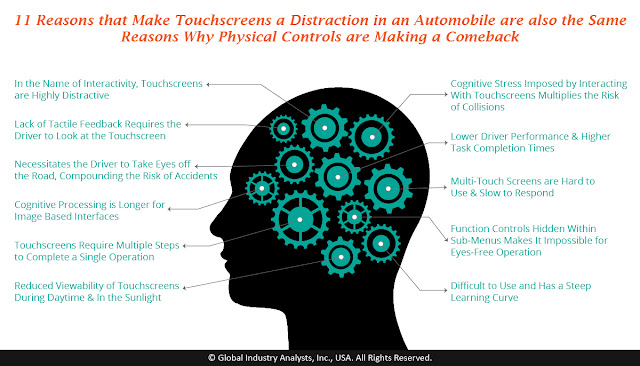The global market for Automotive Control
Panel is projected to reach US$129.4 billion by 2025, driven by electronification
and electrification trends, and the resulting increased interactions in a
connected semi-autonomous car. Intuitive and safe automotive controls are
gaining significant importance in automobile designs. An adroit balance of usability,
performance and safety are key features for vehicle interfaces that need to be
balanced for a successful control system design. Today, the key selling point
for auto OEMs is performance of the electronics, unlike earlier when a car’s
road performance took precedence. The transition to motorized controls increases
the importance of automotive control systems. The growing proliferation of
touchscreen vehicle head units and center console units has created a safety challenge
for OEMs. Automotive touchscreens have hit the peak of inflated expectations in
their hype cycle, driven mostly by vendor assisted marketing and promotional strategies.
Emerging signs of the technology being a failure in cars indicates that
touchscreens are heading towards the trough of disillusionment where inflated
expectations begin to die down. The scenario creates a tipping point for the
traditional keyboard based systems. Interestingly, major reasons that make
touchscreens a distraction in an automobile are also the same reasons why
physical controls and control panel units are making a comeback. Few of the disadvantages
of automotive touchscreens include high distraction index; lack of tactile
feedback requires the driver to look at the touchscreen; necessitates the
driver to take eyes off the road compounding the risk of accidents; longer
cognitive processing for image based interfaces; requires multiple steps to
complete a single operation; lower driver performance and higher task
completion times; difficult to use and beset with a steep learning curve. More
number of cars in the coming years will therefore come out with touchscreens embedded
alongside a set of fixed, physical buttons. Read More…
The Global Market for Private Tutoring Services is Forecast to Reach US$227 Billion by 2022
Intense Competition among Students and the Growing Need to Achieve Academic Excellence Drive the Global Private Tutoring Market, According to a New Report by Global Industry Analysts, Inc. GIA launches comprehensive analysis of industry segments, trends, growth drivers, market share, size and demand forecasts on the global Private Tutoring market. The global market for Private Tutoring Services is forecast to reach US$227 billion by 2022 , driven by the need to keep pace with classroom teaching, improve overall competency and enhance knowledge and skill level. Education is considered the social ladder to achieve success in personal and professional life. Higher education is associated with increased opportunities in the labor market, high remunerations, and improved social standing. People are therefore investing heavily in children’s education, including private tutoring or private supplementary tutoring which is emerging as a major phenomenon in the global education system...


Comments
Post a Comment